Home > National Prevention Week: Celebrating Collaborations for Comprehensive Prevention
By Cele Fichter-DeSando, MPM
Each year, National Prevention Week (NPW) occurs in May to raise awareness about the importance of substance use prevention and positive mental health. Annually, the week includes daily themes to focus on major substance use and mental health topics and a special way to get involved. This year, share your prevention story on any platform using #MyPreventionStory. NPW will be held next week, May 8-14th. The 2022 daily NPW themes are
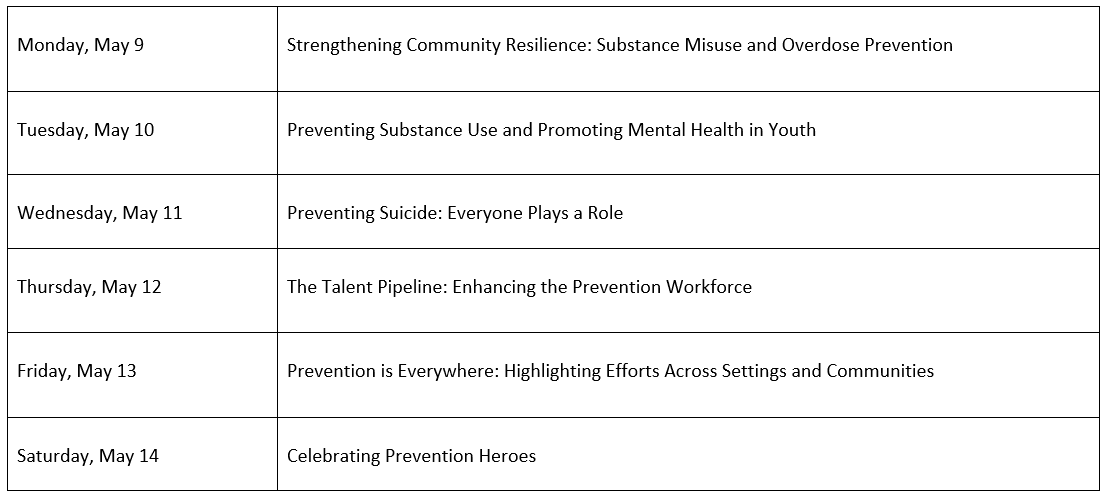
Perfect Timing for Collaboration
The Substance Abuse and Mental Health Services Administration (SAMHSA) chose May for NPW because it is near the start of summer and provides schools, communities, families, and prevention professionals with an opportunity to strengthen and celebrate prevention activities as one season ends and another begins.
According to National Survey on Drug Use and Health (NSDUH), data on adolescents – 2012 (PDF | 704 KB) and NSDUH data on full-time college students – 2015 (PDF | 1.2 MB) show that adolescents and full-time college students most often use substances for the first time during June or July. Educators, parents, and prevention practitioners can use NPW as a way to reach out to children, youth, and young adults with focused prevention strategies at a crucial time of transition.
NPW is not only for prevention with children and youth. To strengthen individual, family, and community health, SAMHSA has expanded NPW to celebrate prevention and collaboration across all communities and across all ages.
The goals of NPW are to:
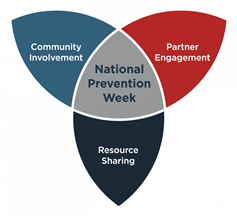
National Prevention Week | SAMHSA promotional materials, a planning toolkit, and information about community events and activities are available online to help facilitate collaborative efforts.
NPW gives prevention practitioners an opportunity to collaborate with prevention organizations to envision and build a comprehensive system that provides a wide range of evidence-based prevention services across all age groups.
Celebrate NPW with Collaboration
NPW collaboration can begin by connecting with the Prevention Technology Transfer Center (PTTC) Network. The Prevention Technology Transfer Center (PTTC) Network was established by SAMHSA to improve the implementation and delivery of effective substance misuse prevention interventions and provide training and technical assistance services to the prevention field. The PTTC Network, consisting of ten regional PTTCs and two national population focused PTTCs, develops and disseminates tools and strategies needed to improve the quality of substance misuse prevention efforts. They provide intensive technical assistance and learning resources to prevention professionals in order to improve their understanding of prevention science, epidemiological data, and the implementation of evidence-based and promising practices. The PTTC Network continually develops tools and resources to engage the next generation of prevention professionals. The PTTC Network’s Community Coalitions and Collaborators Priority Area (3Cs) Working Group develops training and technical assistance tools, products, and services on effective community coalitions and collaborations.
Prevention and Harm Reduction and Community Collaboration
As we kick off NPW, the 3Cs PTTC Working Group is planning a webinar training series for June 28th and 30th 2022 focusing on Prevention and Harm Reduction. The virtual series will focus on how community collaborations can work across the continuum of care to maximize impact and sustain systems-level changes that promote wellness for everyone. A framework for understanding harm reduction strategies by sharing the history and pillars of harm reduction as a social movement and examples of various types of harm reduction strategies will be provided as a major focus of the training. Prevention coalition and prevention practitioner participants will explore how the goals and values of prevention intersect with harm reduction and how community collaborations working together can address overlapping goals to enhance implementation strategies across the continuum of care. In addition to information on the upcoming training, the Community Coalitions and Collaborators Priority Area website has toolkits, webcasts, and other materials to assist with effective community collaborations.
The Intersection of Prevention and Harm Reduction Collaboration
The framework for understanding how prevention and harm reduction intersect is illustrated by SAMHSA’s inclusion of harm reduction as a comprehensive prevention strategy and an integral part of the continuum of care. Prevention Programs that incorporate harm reduction can reduce negative effects on health and social wellbeing due to the use of alcohol, other drugs, and related behaviors. Prevention Goals and Harm Reduction Activities can intersect as part of a comprehensive prevention program as illustrated in the SAMHSA table below.
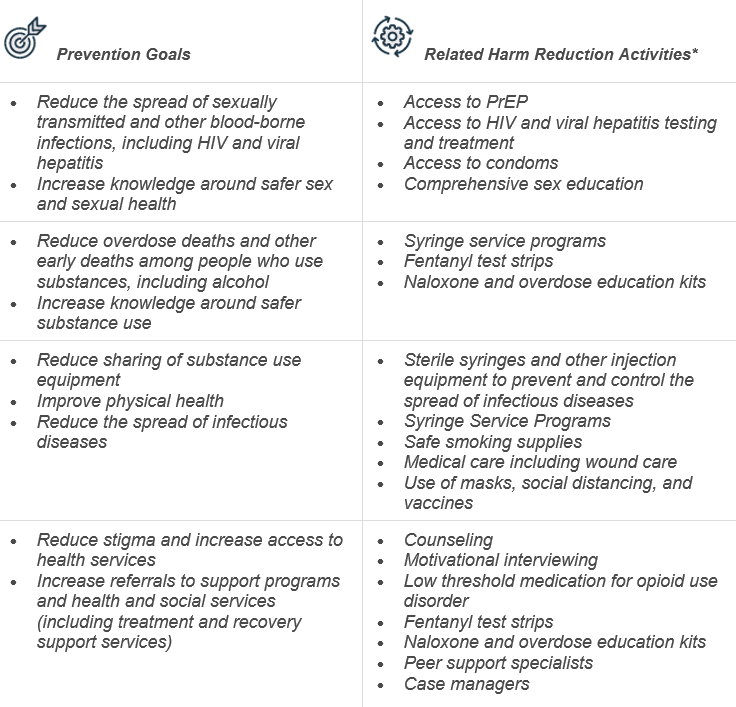
*Note: Sample harm reduction activities can meet multiple prevention goals.
SAMHSA has collaborated with the Centers for Disease Control (CDC) on their National Harm Reduction Technical Assistance Center (NHRTAC) to provide a comprehensive approach to harm reduction. NHRTAC provides free help to anyone in the country providing (or planning to provide) harm reduction services to their community. This may include syringe services programs, health departments, programs providing treatment for substance use disorder, as well as prevention and recovery programs. CDC established and expanded the NHRTAC in collaboration with SAMHSA to ensure comprehensive support for the integration of harm reduction strategies and principles across diverse community settings and within a prevention and treatment framework.
Building a Comprehensive Prevention System
Another tool for collaboration in building comprehensive prevention systems is Applied Prevention Science International (APSI). APSI is a not-for-profit organization that provides a bridge between the rigors of prevention science and the needs of prevention policy and practice. APSI provides education, training, consultation, technical assistance, and guidance on implementing evidence-based prevention programming systems of care. APSI provides a weekly blog post PREVENTION NUGGETS to deliver key information to prevention professionals around the world. Topics include prevention science and practice, etiology models, critical theories, ethics, environments for prevention, and many other issues fundamental to evidence-based prevention practice. In a recent APSI blog post on building prevention systems, APSI uses the Institute of Medicine (IOM) prevention classifications of universal, selective, and indicated prevention, and identifies 8 consumer service groups that require prevention and/or harm reduction services.
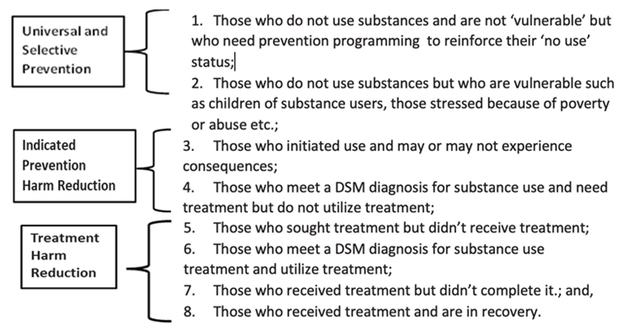
These eight consumer groups do not benefit from a one size fits all prevention program and can serve as a guide to developing comprehensive services that meet the needs of various populations in various stages along the continuum of care.
Conclusion: Comprehensive prevention services are highlighted and celebrated during NPW but do not end there. Comprehensive prevention services are part of an ongoing process of collaboration to provide integrated evidence-based services for all ages, and all groups in all communities. This May, celebrate all of your prevention efforts, recognize the progress that has been made, and collaborate with other organizations and communities to continue the building of comprehensive prevention systems.
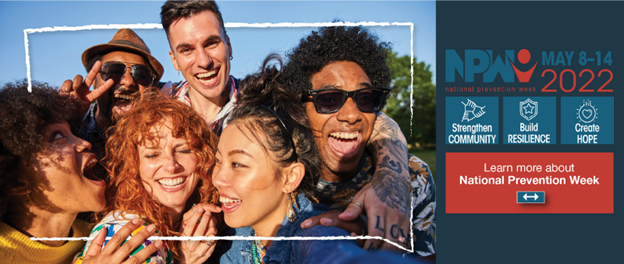
Author's Contact Info:
Cele Fichter-DeSando, MPM (She, Her, Hers)
7069 Highland Creek Drive
Bridgeville PA, 15017
412-580-3089
[email protected]
References
Applied Prevention Science International. 2022. Building Prevention Systems, Blog Post. March 16, 2022. APSI Retrieved April 14, 2022. https://www.apsintl.org/post/building-prevention-systems
Lipari, R.N. Monthly Variation in Substance Use Initiation Among Full-Time College Students. The CBHSQ Report: August 27, 2015. Substance Abuse and Mental Health Services Administration, Center for Behavioral Health Statistics and Quality. Rockville, MD. Retrieved on April 14, 2022. https://www.samhsa.gov/data/sites/pttc/files/report_2049/ShortReport-2049.pdf
The National Harm Reduction Technical Assistance Center (NHRTAC) Retrieved April 14, 2022. https://harmreductionhelp.cdc.gov/s/ Monthly Variation in Substance Use Initiation among Adolescents. July 2012. Retrieved on April 14, 2022. https://www.samhsa.gov/data/sites/pttc/files/NSDUH080/NSDUH080/SR080InitiationSubstanceUse2012.pdf
National Prevention Week SASMHA Website 2022. Retrieved on April 14, 2022. https://www.samhsa.gov/prevention-week
The National Survey on Drug Use and Health. (NSDUH).
The Prevention Technology Transfer Center Network (PTTC). 2022 https://pttcnetwork.org/
Springer, John & Phillips, Joël. (2007). The Institute of Medicine Framework and its implication for the advancement of prevention policy, programs and practice. Retrieved April 14, 2022. https://www.naspa.org/images/uploads/events/WHPL_Canon_Pr_IOM_article_Springer_Phillips_Final.pdf
Substance Abuse and Mental Health Services Administration (SAMHSA) 2022. Harm Reduction Page. Retrieved April 14, 2022. Harm Reduction SAMHSA.